Keynsham, Somerset
Up to 1834
A parliamentary report of 1777 recorded parish workhouses in operation at Keynsham (with accommodation for 6 inmates), Brislington (12), Bitton (25), and Mangotsfield (60).
What is now Priston's village hall served as the parish workhouse until 1838 when it was extensively altered and converted to school.
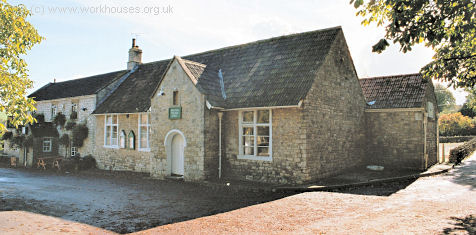
Priston former parish workhouse, 2004.
© Peter Higginbotham.
Bitton had a poorhouse on its High Street with a pin factory adjoining. Two adjacent cottages were once the village constable's house and lock-up
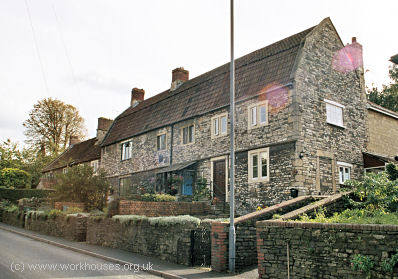
Bitton former parish workhouse and pin factory (right) with constable's house and lock-up beyond, 2004.
© Peter Higginbotham.
Kingswood (not to be confused with the village near Wotton-under-Edge) became a separate parish in the 1890s, having previously been part of Bitton. A workhouse, now demolished, existed there and was centred on 5 Church Road (formerly Poorhouse Lane).
A workhouse at Mangotsfield was built in 1833-4 at the west side of what is now Richmond Road. The building survived until the 1920s. The site is now covered by the housing of Richmond Road and Balmoral Court.
After 1834
The Keynsham Poor Law Union formally came into being on 29th March 1836. Its operation was overseen by an elected Board of Guardians, 26 in number, representing its 19 constituent parishes as listed below (figures in brackets indicate numbers of Guardians if more than one):
County of Somerset:
Brislington, Burnett, Compton Dando, Corston, Kelston, Keynsham (2), Marksbury, Newton St Loe, North Stoke, Priston, Queen Charlton, Saltford, Stanton Prior, Whitchurch.
County of Gloucester:
Bitton (2), Hanham, Mangotsfield (3), Oldland, Siston.
Later Additions (from 1894): Hanham Abbots, Kingswood.
The population falling within the Union at the 1831 census had been 20,205 with parishes ranging in size from from Burnett (population 82) to Mangotsfield (3,508). The average annual poor-rate expenditure for the period 1833-35 had been £7,040 or 7s.0d. per head of the population.
A new Keynsham Union workhouse was erected in 1837 at a site to the south of Keynsham. The Poor Law Commissioners authorised an expenditure of £4,960 on construction of the building which was intended to accommodate 300 inmates. The workhouse was designed by William Armstrong and was based on the model "square" plan published by the Commissioners in 1835. The site location and layout are shown on the 1915 map below.
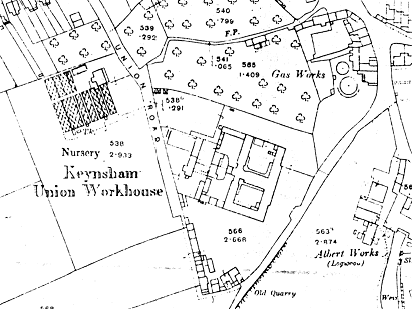
Keynsham site, 1915.
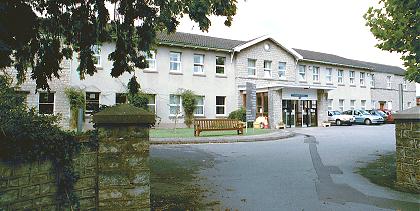
Keynsham entrance block from the south-east, 2000.
© Peter Higginbotham.
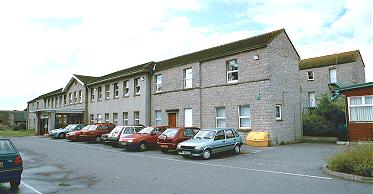
Keynsham from the north-east, 2000.
© Peter Higginbotham.
A detached infirmary block was erected at the west of the workhouse in the latter part of the nineteenth century. It was extended at its northern end in 1903.
The workhouse site later became Keynsham Hospital. The surviving workhouse buildings were demolished in July 2007.
Staff
Inmates
Records
Note: many repositories impose a closure period of up to 100 years for records identifying individuals. Before travelling a long distance, always check that the records you want to consult will be available.
- Somerset Heritage Centre, Brunel Way, Langford Mead, Norton Fitzwarren, Taunton TA2 6SF. Holdings include: Guardians' minute books (1837-1930); Admissions and discharges (1836-1930, with gaps); Births (1836-90); Baptisms (1890-1915); Creed register (1869-1933); Offences and punishment book (1838-95); etc.
Bibliography
- Higginbotham, Peter The Workhouse Encyclopedia (2014, The History Press)
Links
- None.
Unless otherwise indicated, this page () is copyright Peter Higginbotham. Contents may not be reproduced without permission.


